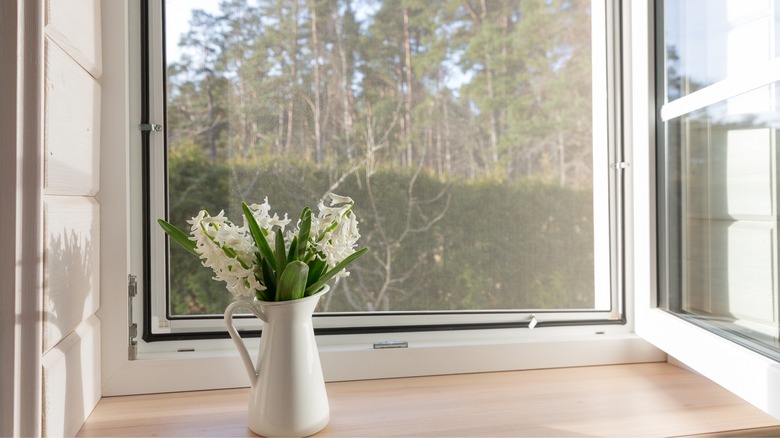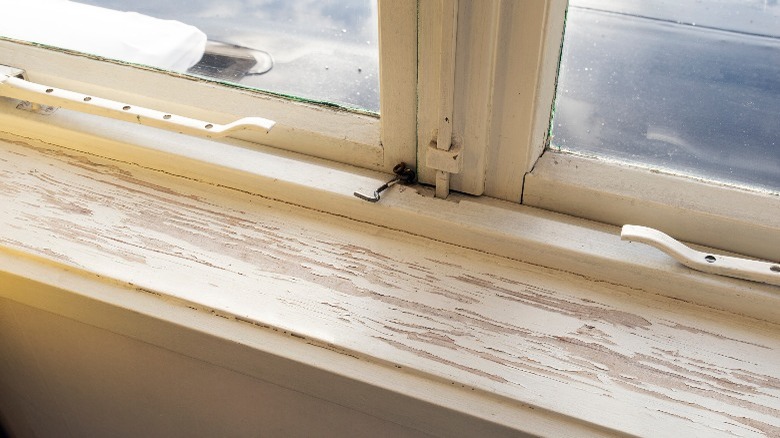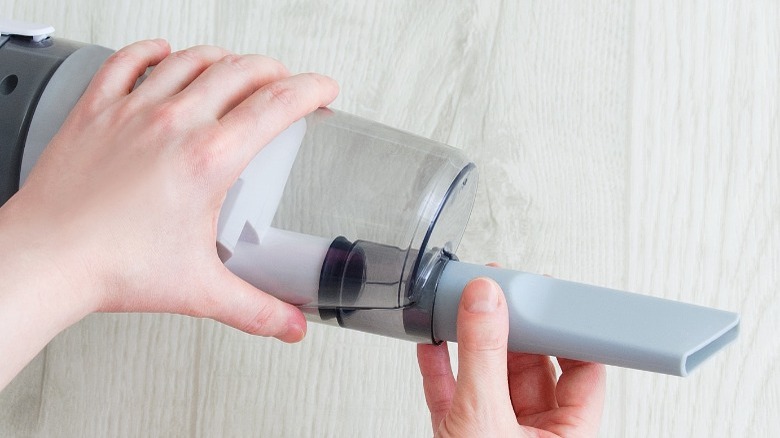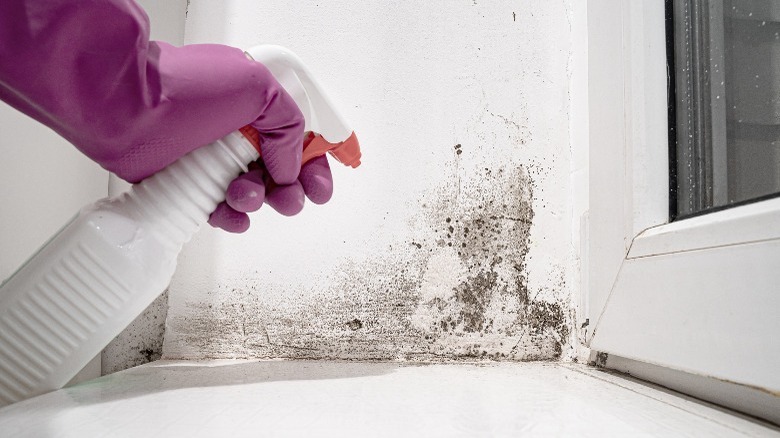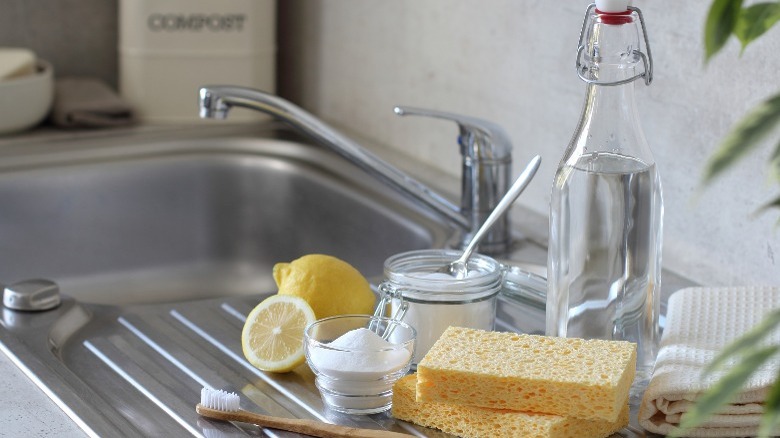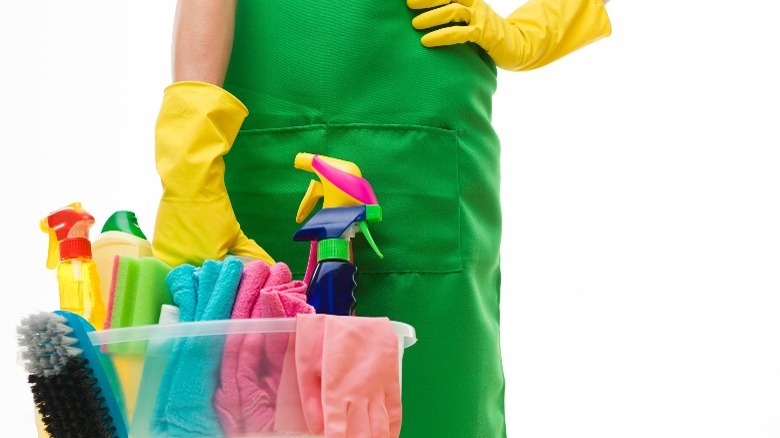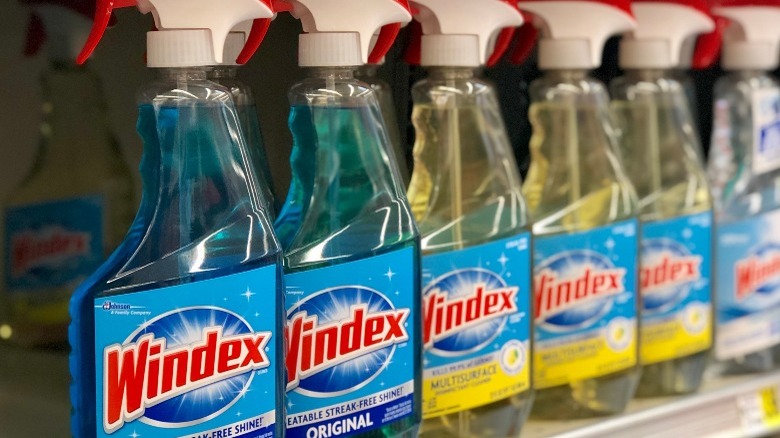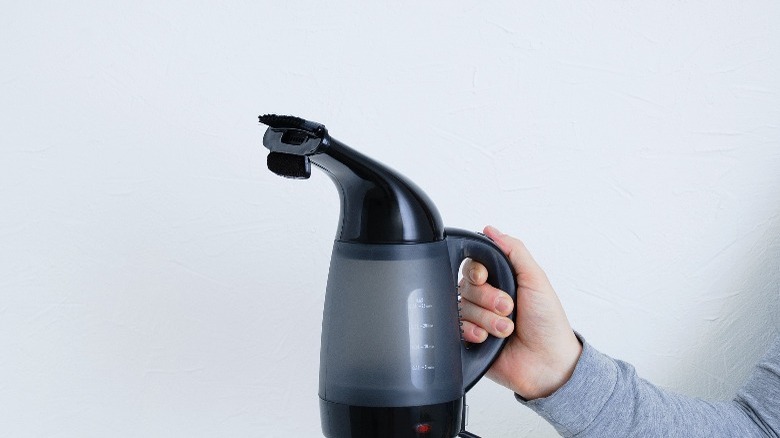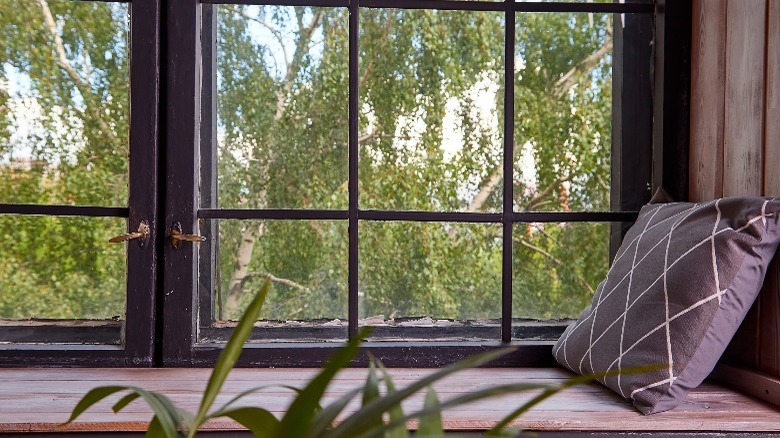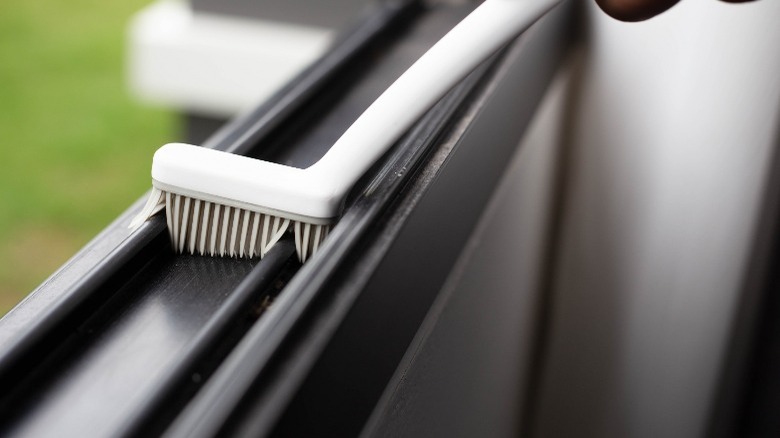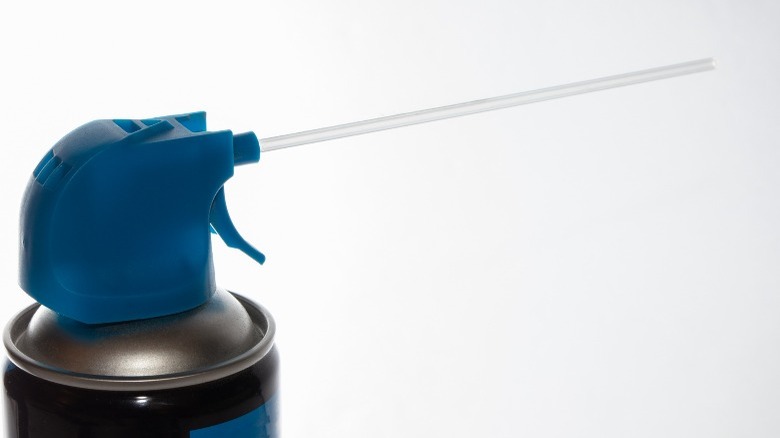The Best Way To Clean Window Tracks
We may receive a commission on purchases made from links.
If you aren't sure what window tracks are, it first helps to know what a window sash is. Pella explains that this movable part of a window frame holds the glass, and goes up and down inside the frame. Double-hung windows have two sashes, and these slide along narrow areas called raceways or tracks. That is where the dirt and debris accumulate.
Your window track rests behind your window sill and also holds your window in place. The track keeps out drafts and allows you to open and close your window smoothly. However, the track's nooks and crannies allow dust, dirt, allergens, and insects to get stuck and then accumulate quickly. In addition to ruining your windows' visual appeal when the sashes are open, debris in your window tracks can cause your windows to stick and the tracks and casements to warp, as per Angi. The dirt and debris can come from inside or outside your home.
It is common for most homeowners never to clean their tracks, but doing so regularly is important to prevent bacteria, mold, and other allergens from forming, which can all impact indoor air quality and your health. Well-maintained window tracks and frames will also last longer, which extends their life and can save you money.
Check the tracks for damage first
Modernize Home Services claims that vinyl windows and tracks should last for 10 to 20 years, but can show signs of damage before then. This can be due to the house settling naturally, excessive moisture, or the window getting smashed by an object (via Build with Rise). It is a good idea to check a window and frame if you know something hit it or after a bad storm, and to look for holes, cracks, and broken seals in the frame and tracks before cleaning. It will cost about $175 per window frame for major repairs, but you can fix minor ones yourself.
Your first thought might be to cover the damage with heavy-duty tape, grout, or glue, but it's best to start with vinyl window repair kits. These cost around $15 to $25 and usually include vinyl patches, adhesives, and a simple repair tool. Check all of your windows before ordering a kit, as you may need more than one.
To cover up cracks and holes in the frame, clean out debris with a butter knife and use medium-grit sandpaper to smooth rough edges. Outline the hole with a pencil and carefully cut it out with a razor blade. Measure the spot again and cut out two vinyl patches — one should fit the space perfectly, and the other should be slightly larger. Place the adhesive on one side of the smaller piece and insert it into the hole. Apply more adhesive on top of it, and place the larger patch on top. Press it down with the tool, let it dry for 24 hours, trim the excess, and sand it down.
Pull out your vacuum attachment or hand vac
You might be shocked to see how much dirt and debris has accumulated in your window tracks, but hold on a minute, because spraying a ton of window cleaner on there will only lead to a dark, sludgy mess. Wcma Net Window & Door takes a clean toothbrush or small, soft brush to sweep out the tracks first, but you'll need something else for any dirt accumulated in the crevices and corners. A handheld vac or hose attachment can do this, as long as it has a crevice attachment tool.
Smart Vacuum Guide explains that these tools are made from plastic, but instead of being rounded at the end, they are flat with narrow, angled slits on one side. Some are designed to attach to vacuum cleaner hoses and extension wands, but there are also ones made for hand vacuums. These small attachments are prone to get lost, but you can buy them separately at home supply stores and other retailers. Some may be generic, but you can also look for ones made by the same manufacturer as your vacuum or hand vac. Crevice tools are also suitable for cleaning other small spaces, like in between baseboards and carpets, beneath the fridge, and inside your car or truck.
>>>Treating mold and oxidation with bleach
Jenkins Environmental Services posts that mold forms on vinyl, aluminum, and wood window frames when moisture gets trapped close to the joints. Mold on wood can be green, black, orange, and other colors. Oxidation on vinyl window frames and tracks has a chalky, white appearance, but according to The Craftsman Blog, it looks grayish on aluminum. To get rid of rust, try a specially-formulated removal product or mix up 1/3 of a cup of laundry detergent, 2/3 cup of powdered household cleaner, 1 quart of bleach, and 1 gallon of water. Pour it into a spray bottle or bucket and scrub gently with a soft-bristled brush. If mold is your problem, Modernize suggests mixing 2/3 cup of powdered household cleaner, 1/3 cup of detergent, and 1 quart of bleach into 1 gallon of water.
Pelican Replacement Windows prefers using a 30% vinegar/70% water mixture, which might not have as much power as the cleaner/detergent/bleach recipe. You can try this method first, as bleach is harsher. Pour the vinegar and water into a spray bottle, and spritz it on the mold or rust. Allow it to sit for 15 minutes, and scrub gently with a toothbrush. Wipe it down with a clean, wet sponge and see if the spots have dissolved. If not, mix the household cleaner, detergent, and bleach, and apply that in the same way. Never combine vinegar and bleach – Grove Collaborative posts that this creates dangerous chlorine gas. As an added note of caution, don a safety mask, goggles, cleaning gloves, and a long-sleeved shirt when working with bleach, since it has a strong smell and irritates the eyes and skin.
Cleaning window tracks with baking soda and vinegar
If you prefer sticking with natural cleaners, The Intentional Mom uses baking soda, white vinegar, and household supplies like an old toothbrush, paper towels, a rag, and a butter knife to clean window tracks. Safe Household Cleaning points out that since vinegar is an acid, it can penetrate bacterial cells — it is a safe and effective cleaner that does not harm the environment, either. If the smell is too intense, All American Window and Door recommends adding a bit of lemon juice.
To get started with this method, pull out a box of baking soda and sprinkle some into the dirtiest parts of the tracks, including the corners. Next, pour about 1 cup of vinegar into a spray bottle and spritz it onto the soda — let that bubble up and then rest for five to 10 minutes. Take a clean, old toothbrush and work from the edges of the tracks into the middles. You can wipe this up with paper towels or clean, damp rags. Then, dampen another clean rag and cover the top of a butter knife (or other blunt-edged, slim tool) with it. Now you can get into the narrow parts and corners. Once that is done, you can do one final swipe with a pre-moistened cleaning wipe.
Another recipe for a homemade window track cleaner
She Wears Many Hats has a slightly different recipe for a homemade glass cleaner that can be used on window tracks and claims it works well on exterior window frames. She combines 2 cups of water, 1/4 cup of white vinegar, plus 1/2 a teaspoon of dish detergent into a bucket. This gets scrubbed into the tracks with a soft bristle brush and is then rinsed with clean water before it has dried. It can also be spritzed into the nooks and crannies with a spray bottle.
To use this cleaner outdoors, you may need to place the scrub brush onto an extension pole. It can then get rinsed off with a hose fitted with a sprayer attachment. If your home has hard water, distilled water can do a much better job, although it will be slightly more expensive than tap water since you have to go out and buy it. Afterward, you can label any leftover cleaner, especially if you have small children or pets at home.
All American Window and Door claims that vinyl window frames can be sensitive to harsh cleaners, adding that some people do not want to use vinegar because of the smell. Its alternative is to use a non-detergent soap in the ratio of ¼ cup to 1 gallon of warm water. This is applied and rinsed off in the same way and is a good option if you are unsure how your vinyl window tracks will react to vinegar or other cleaning solutions.
Use store-bought glass cleaner
You can shop for all-natural, eco-friendly glass cleaners that clean well, but many of these will have a vinegar or alcohol smell. They are generally made with plant-based ingredients, so you can feel good about using them. And since Safe Household Cleaning writes that store shelves are packed with these cleaning products, so you shouldn't have a problem finding one that you like. Some of them only use renewable energy sources, and you can also look for biodegradable and cruelty-free ones. Environmentally-friendly cleaning products are also appropriate for people who experience side effects from traditional cleaners (breathing difficulties and allergic reactions).
The other option here is a regular store-bought window cleaning product like Windex. These sprays can be just as effective as homemade ones and are used similarly. Your Best Digs lists its favorites, which include some that are tough on grease and others that are fragrance-free. Window cleaning products may contain ammonia, but the smell should not last long enough or be too strong to be offensive. A penetrating foam window cleaner can also work very well on dirty tracks, and you can let it sit for five minutes or so until wiping it away with a soft-bristle brush, toothbrush, paper towel, or clean rag.
You can try a few of these until you find a favorite to use on your frames, tracks, and glass. If it leaves behind streaks or spots, it could be that old cleaning rag you've been using. Try again with paper towels or newspapers and if that doesn't do the trick, try another brand.
Can you steam clean window tracks?
Merry Maids pulls a clever trick out of its hat: using a garment steamer to clean window tracks. It is a decent cleaning hack if you take certain precautions. This tool can be used on vinyl, aluminum, and wood windows, and you will also need distilled water, a vacuum with a crevice tool, and cleaning cloths. While waiting for your steamer to boil, use your vacuum attachment or crevice tool to remove as much dirt as possible. Then, use the steamer to break up any remaining gunk in the tracks. Wipe it out with a microfiber cloth or paper towel. Check carefully, and if there is still dirt left, steam it, and wipe it away as needed.
As for those precautions, garment steamers create 212 degrees Fahrenheit and higher steam, so don't point it at your body and keep it away from children and pets. Distilled water is best since tap water can leave mineral traces behind. Do not use this tool on window frames that are painted or stained; steamers should also never be used on porous, unsealed surfaces, either.
What, you don't have a garment steamer? You might not want to buy one just for cleaning window tracks, but aside from smoothing out wrinkles in clothes, The Maids uses steamers in other ways. These versatile tools can clean curtains and couches and remove carpet stains, but read the manufacturer's label first. Take heed if one reads "dry clean only" or has another warning. Garment steamers may also degrease and sanitize surfaces and can even defrost freezers.
Cleaning wood window tracks
Like vinyl and aluminum window frames, wooden ones should be checked and cleaned regularly for deterioration and damage. You can use your vacuum tool to remove dirt and dust first and check for cracks or mold in the frame and tracks. Real Homes posts that dampness causes mold to form on wood, and that unfinished wood is likelier to succumb since it is not sealed. Put on your protective gear (always do this when cleaning up mold), vacuum up as much as possible, and thoroughly clean the filter.
Add 1 teaspoon dish soap to 1 cup of warm water and apply to the mold. Scrub carefully with a toothbrush, rinsing and repeating as needed. If the wood is untreated, the mold may have penetrated beneath the surface. You can mix up equal parts of vinegar and water and apply that to the stains if the dish soap doesn't get down deep enough. For untreated wood, swap out that dish soap for 1 tablespoon of bleach, let it sit for 60 minutes, wipe it away with a clean cloth, and rinse.
Home Supply Window & Door cleans wood window frames and tracks using similar methods as used with vinyl versions. First, remove loose dirt and dust with a dry, soft cloth, and look for holes, peeling, or cracks. The frame and tracks can be cleaned with a few drops of mild detergent mixed in warm water. The cleaning cloth should be damp but not soaking wet. Once washed, wipe everything down with a clean, damp cloth to remove the suds. Make a final pass with a dry cloth, and you are finished once the frames and tracks are dry.
Use a windowsill brush cleaning set
Window tracks can be pretty narrow, and sometimes a toothbrush is too wide to get into the nooks and crannies. When this is the case, you can cut down a clean, dry sponge into slim pieces or use a pipe cleaner. Another option is to get a window sill brush cleaning kit. These sets have different tools designed to fit into the tracks and make the job easier. The small plastic tools that they come with easily slip into hard-to-reach places, and can be used for other cleaning tasks.
This window sill brush cleaning kit on Amazon comes with a window track cleaning brush, a tile lines brush, a dustpan clean brush, a handle groove gap brush, and a window blind brush. The gentle nylon bristles won't damage surfaces, and that window track brush is especially good at getting into corners. Use it just like a toothbrush for cleaning the tracks. You can clean keyboards, bathroom fixtures, and beneath sinks. If you decide to get one of these kits, keep all the pieces stored together in a sealed bag or closed drawer so you won't lose any.
Use a paintbrush and compressed air
Tidy Life Happy Wife has yet another hack that can make your window tracks look like new: compressed air. To get started, she closes the window and uses a stiff-bristled paintbrush to loosen up dirt and debris in the tracks and around them. Next comes the vacuum brush attachment, to suck up what you have stirred up. Open up the window as far as it goes, and wipe up anything else with a dry microfiber cloth. To work on the tracks, pick up the paintbrush again and dig in, working from sides in towards the middle; vacuum it up.
Close the window, and dip the paintbrush in your homemade cleaning mixture or product. The brush should be damp but not dripping when you use it – scrub the upper part of the tracks and the locking mechanism, closing and opening the latter to get into all its crevices. Here's where the compressed air comes in. Using short, quick blasts, spray those hard-to-reach areas to get out the gunk. You can wipe that away with your microfiber cloth, open the window, and repeat the process on the bottom part of the tracks. Voilà! Those tracks will be sparkly clean.
